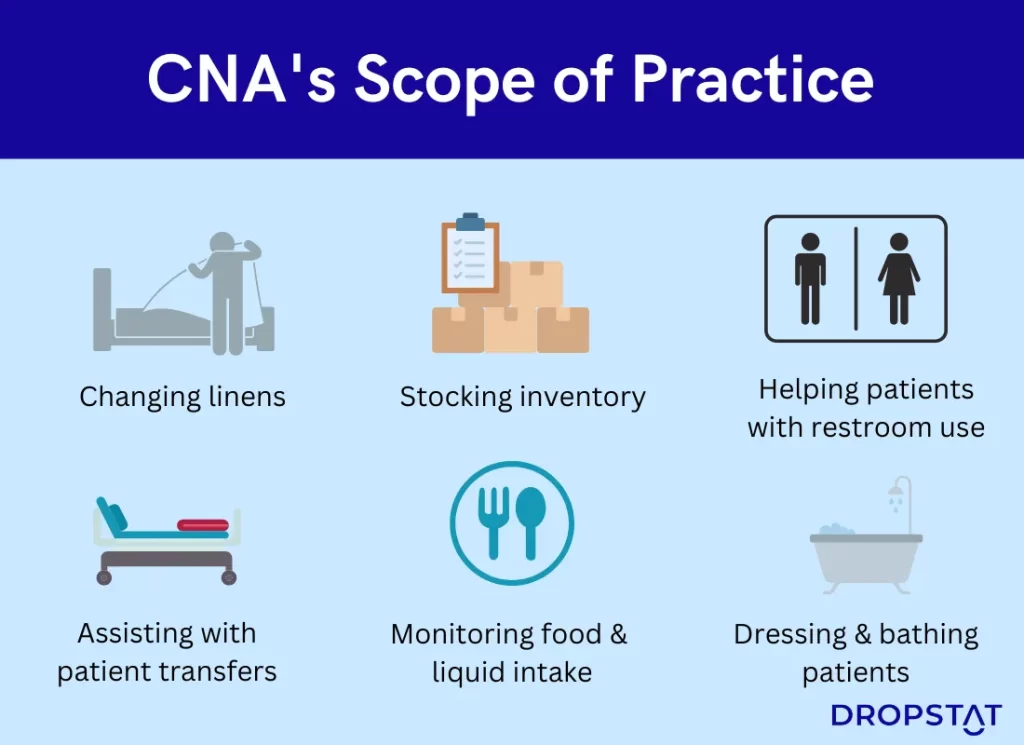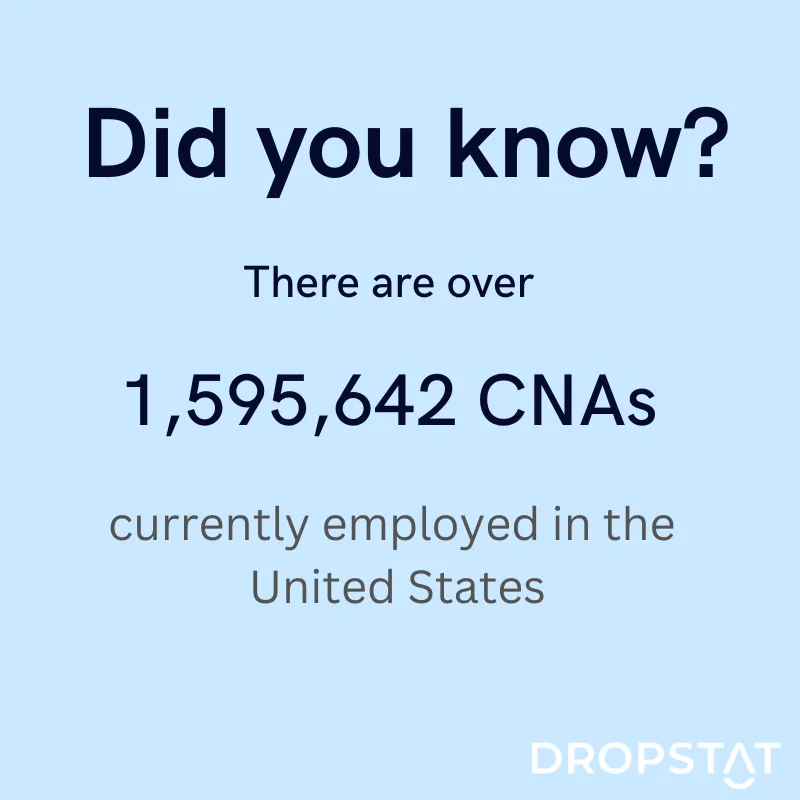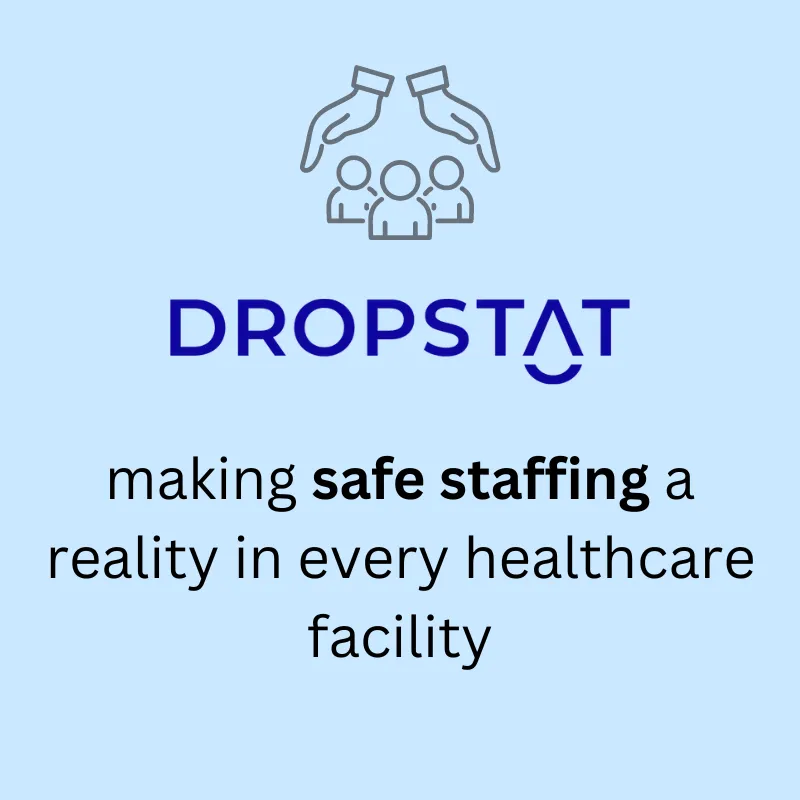Dropstat’s Clickable Guide to Types of Nursing Specialties
What role do CNAs take on in healthcare?
Although Registered Nurses (RNs) are licensed to complete a broad scope of patient-centered tasks, a healthcare team composed solely of RNs is not necessarily the best use of your facility’s resources. When job duties that can be completed by lower-level nursing staff are consistently assigned to RNs, facilities allocate unnecessary funds to RN shifts. RNs are highly skilled care providers, and if they are weighed down by basic patient care tasks, they may not be able to complete more skilled tasks efficiently. Asking ‘What is a CNA?’ means being open to hiring different types of nurses that can increase support for RNs. This means – that hiring Certified Nursing Assistants (CNAs) and other assistive personnel enables RNs to take on additional management positions and focus on more specialized areas of care.
What does a CNA do?
CNAs assist with numerous one-on-one tasks that include:
- Monitoring food and liquid intake
- Repositioning patients in beds
- Answering patient calls
- Assisting with patient transfers
- Bathing patients
- Changing linens
- Stocking inventory
- Dressing patients
- Helping patients with restroom use
- Ensuring hygiene is prioritized
Considering that CNA training and education are limited, there are other aspects of care that CNAs are typically not allowed to complete, such as:
- Administering injections
- Bowel evacuation
- Tube feeding
- Open wound care
- Inserting catheters
- Inserting IVs
Since regulations are state-dependent, it is crucial to investigate the limitations of CNA responsibilities in different states.
The average CNA salary vs a traveling CNA salary
The average salary for traveling CNAs in the US is predicted to be $48,750, while the average salary of permanent CNA staff is $34,352. Even though hiring permanent CNAs is preferable for the goal of improving employee retention and minimizing excess costs, traveling CNAs are a great alternative to fill shifts that are less likely to be filled by permanent staff. Additionally, traveling CNAs can significantly improve overall support for a care team during times with particularly high patient volume, such as holidays.

Traveling CNAs – Advantages and Disadvantages
Given that CNAs must hold a license specific to the state where they will provide care, it may not always be ideal to hire a travel CNA.
Benefits of hiring travel CNAs include:
- Although salaries for travel CNAs are higher than typical CNAs, it is much less than salaries for RNs. Your facility will save on excess costs by hiring travel CNAs instead of additional RNs.
- Additional travel CNAs support RNs by completing lower-level patient care tasks that RNs are overqualified for. This reduces the time patients spend waiting for help and improves patient satisfaction.
- Since travel CNAs are temporary staff, facilities avoid recruitment and hiring costs that would be involved in hiring permanent staff. Specifically, if the travel CNAs are only required for short durations such as holidays, management can avoid using resources meant for permanent staff.
Disadvantages of hiring travel CNAs are:
- A CNA license does not grant the autonomy that an RN license does, and when travel CNAs are hired, RNs must put greater effort into overseeing them, which may make RNs feel overworked. If your facility does decide to hire more travel CNAs, it is crucial that there is a system in place to address potential burnout and acknowledge the work that RNs do.
- As mentioned previously, travel CNAs have higher salaries than permanent CNA staff, so administrators should verify that the shifts being filled by travel CNAs are not better suited for permanent staff.
CNA training
Additional CNA certification allows for a greater scope of care and benefits to the whole care team. A CNA who holds certifications in care environments like geriatric care and hospice/palliative care often commands higher salaries than typical CNAs to reflect the additional areas of knowledge and skillsets and the advantages they bring to the care team. Within five weeks to nine months, CNAs can become patient care technicians (PCTS) as well, enabling them to assist with medication administration and help with preparing patients before surgery, among other critical tasks often left to higher-level nurses. Hiring qualified CNAs for these tasks relieves some of the workload from RNs.

CNA vs. LPN scope of practice
CNAs and LPNs both play a critical role in supporting RN staff. However, their scope of practice is different regarding the responsibilities and education required by each profession. CNAs must complete a minimum of four weeks of training before becoming certified, whereas the length of LPN certification programs is usually one year. LPNs also take on greater clinical tasks, whereas CNAs are limited to assisting with activities of daily living.
HHA vs. CNA scope of practice
Home health aides (HHAs) are not responsible for clinical duties when dealing with patients and are not required to obtain certification. However, if the HHA is practicing in a facility that receives Medicaid / Medicare funding, they may require certification. HHAs also work within the home care setting, while CNAs have a greater range of work environments, such as hospitals, nursing homes, and private practices, to name a few. Beyond work environments, HHAs typically supervise a single patient, while a CNA may oversee several patients within their department.
Can your healthcare facility benefit from hiring more CNAs?
Physical care is a top priority among nursing staff. However, you must also support emotional and social well-being. One way you can meet this aspect of care is by hiring additional CNAs. Since CNAs spend more one-on-one time with patients than RNs and other nursing staff, they can provide more emotional support. Patients with an emotional support system have much higher patient satisfaction throughout their care.
Alongside providing emotional and social support, CNAs allow RNs to focus on their specialized clinical tasks instead of daily living or hygiene activities, which optimizes the staffing budget for employing RNs. When a facility has enough CNAs to assist with lower-level patient care duties, RNs can focus more exclusively on tasks requiring more training and skill. In this way, healthcare facilities can optimize their staffing budgets. They will be appropriately paying a bigger salary for more trained staff and skilled labor and a lower salary to less trained staff for less skilled work.
How can Dropstat help your facility identify a need for more CNAs?
Dropstat uses the most advanced AI technology to help facilities predict hiring needs seamlessly. Dropstat tracks nurse overtime and bonus usage across shifts to indicate facility deficits in specific nursing roles and the potential overuse of RNs for less critical care tasks. By implementing the processes that Dropstat provides, your facility can improve overall delivery and satisfaction of care for both patients and staff.







